Influence of Apparatus Scale on Geogrid Monotonic and Cyclic/Post-Cyclic Pullout Behavior in Cohesive Soils
Abstract
:1. Introduction
2. Materials and Methods
2.1. Test Materials
2.2. Pullout Test Devices
2.3. Test Procedures
3. Results
3.1. Monotonic Loading Conditions
3.2. Cyclic/Post-Cyclic Loading Conditions
4. Discussion
5. Conclusions
- In general, in the small-scale tests, no significant deformation occurred over the back half of the reinforcement, as opposed to the large-scale tests, where the geogrid displacements decreased progressively with the distance to the front end, showing a progressive mobilization of the interaction mechanisms at the interface.
- Particularly under lower applied normal stresses, the geogrid pullout resistance was considerably influenced by the apparatus scale and higher values were reached in the large-scale tests. However, the scale effect became less prominent when the applied normal pressure increased. Under post-cyclic loading conditions, the effect of apparatus scale on the pullout resistance values followed the same trend as that observed under monotonic loading.
- Despite the variability for the pullout resistance, the maximum shear stresses obtained from both types of equipment showed reasonable agreement.
- Under normal stresses of 25 and 50 kPa, the geogrid’s confined stiffness at low strains (<2%) derived from the small-scale tests exceeded that from the large-scale equipment. However, under a higher normal stress (100 kPa), the values of confined tensile stiffness obtained from both equipment types were consistent.
- The pullout interface’s apparent coefficient of friction (μs/GSY) decreased with increasing normal stress. While for σn = 25 kPa, the μs/GSY values obtained from the small-scale tests exceeded those from the large pullout box, under higher normal stresses, the differences between the μs/GSY values associated with different test devices were not significant.
Author Contributions
Funding
Data Availability Statement
Acknowledgments
Conflicts of Interest
References
- Göbel, C.H.; Weisemann, U.C.; Kirschner, R.A. Effectiveness of a Reinforcing Geogrid in a Railway Subbase under Dynamic Loads. Geotext. Geomembr. 1994, 13, 91–99. [Google Scholar] [CrossRef]
- Berg, R.; Christopher, B.; Samtani, N. Design and Construction of Mechanically Stabilized Earth Walls and Reinforced Soil Slopes—Volume I; Fhwa: Washington, DC, USA, 2009. [Google Scholar]
- Byun, Y.H.; Tutumluer, E. Local Stiffness Characteristic of Geogrid-Stabilized Aggregate in Relation to Accumulated Permanent Deformation Behavior. Geotext. Geomembr. 2019, 47, 402–407. [Google Scholar] [CrossRef]
- Touze, N. Healing the World: A Geosynthetics Solution. Geosynth. Int. 2021, 28, 1–31. [Google Scholar] [CrossRef]
- Vieira, C.S.; Lopes, M.L.; Caldeira, L.M. Sand-Geotextile Interface Characterisation through Monotonic and Cyclic Direct Shear Tests. Geosynth. Int. 2013, 20, 26–38. [Google Scholar] [CrossRef]
- Palmeira, E.M. Soil-Geosynthetic Interaction: Modelling and Analysis. Geotext. Geomembr. 2009, 27, 368–390. [Google Scholar] [CrossRef]
- Fox, P.J.; Kim, R.H. Effect of Progressive Failure on Measured Shear Strength of Geomembrane/GCL Interface. J. Geotech. Geoenviron. Eng. 2008, 134, 459–469. [Google Scholar] [CrossRef]
- Hsieh, C.W.; Chen, G.H.; Wu, J.H. The Shear Behavior Obtained from the Direct Shear and Pullout Tests for Different Poor Graded Soil-Geosynthetic Systems. J. GeoEngin. 2011, 6, 15–26. [Google Scholar] [CrossRef]
- Palmeira, E.M.; Milligan, G.W.E. Scale and Other Factors Affecting the Results of Pull out Tests of Grids Buried in Sand. Geotechnique 1989, 39, 511–524. [Google Scholar] [CrossRef]
- Farrag, K.; Acar, Y.B.; Juran, I. Pull-Out Resistance of Geogrid Reinforcements. Geotext. Geomembr. 1993, 12, 133–159. [Google Scholar] [CrossRef]
- Lopes, M.L.; Ladeira, M. Influence of the Confinement, Soil Density and Displacement Rate on Soil-Geogrid Interaction. Geotext. Geomembr. 1996, 14, 543–554. [Google Scholar] [CrossRef]
- Ochiaif, H.; Otani, J.; Hayashic, S.; Hirai, T. The Pull-Out Resistance of Geogrids in Reinforced Soil. Geotext. Geomembr. 1996, 14, 19–42. [Google Scholar] [CrossRef]
- Sugimoto, M.; Alagiyawanna, A.M.N.; Kadoguchi, K. Influence of Rigid and Flexible Face on Geogrid Pullout Tests. Geotext. Geomembr. 2001, 19, 257–277. [Google Scholar] [CrossRef]
- Moraci, N.; Recalcati, P. Factors Affecting the Pullout Behaviour of Extruded Geogrids Embedded in a Compacted Granular Soil. Geotext. Geomembr. 2006, 24, 220–242. [Google Scholar] [CrossRef]
- Teixeira, S.H.C.; Bueno, B.S.; Zornberg, J.G.; Asce, M. Pullout Resistance of Individual Longitudinal and Transverse Geogrid Ribs. J. Geotech. Geoenviron. Eng. 2007, 133, 37–50. [Google Scholar] [CrossRef]
- Cardile, G.; Moraci, N.; Calvarano, L.S. Geogrid Pullout Behaviour According to the Experimental Evaluation of the Active Length. Geosynth. Int. 2016, 23, 194–205. [Google Scholar] [CrossRef]
- Mirzaalimohammadi, A.; Ghazavi, M.; Roustaei, M.; Lajevardi, S.H. Pullout Response of Strengthened Geosynthetic Interacting with Fine Sand. Geotext. Geomembr. 2019, 47, 530–541. [Google Scholar] [CrossRef]
- Ferreira, F.B.; Vieira, C.S.; Lopes, M.D.L. Pullout Behavior of Different Geosynthetics—Influence of Soil Density and Moisture Content. Front. Built Environ. 2020, 6, 12. [Google Scholar] [CrossRef]
- Vieira, C.S.; Ferreira, F.B.; Pereira, P.M.; Lopes, M.D.L. Pullout Behaviour of Geosynthetics in a Recycled Construction and Demolition Material—Effects of Cyclic Loading. Transp. Geotech. 2020, 23, 100346. [Google Scholar] [CrossRef]
- Perkins, S.W.; Cuelho, E.V. Soil-Geosynthetic Interface Strength and Stiffness Relationships from Pullout Tests. Geosynth. Int. 1999, 6, 321–346. [Google Scholar] [CrossRef]
- Palmeira, E.M. Bearing Force Mobilisation in Pull-out Tests on Geogrids. Geotext. Geomembr. 2004, 22, 481–509. [Google Scholar] [CrossRef]
- Chen, C.; McDowell, G.R.; Thom, N.H. Investigating Geogrid-Reinforced Ballast: Experimental Pull-out Tests and Discrete Element Modelling. Soils Found. 2014, 54, 1–11. [Google Scholar] [CrossRef]
- Abdi, M.R.; Zandieh, A.R. Experimental and Numerical Analysis of Large Scale Pull out Tests Conducted on Clays Reinforced with Geogrids Encapsulated with Coarse Material. Geotext. Geomembr. 2014, 42, 494–504. [Google Scholar] [CrossRef]
- Sukmak, K.; Sukmak, P.; Horpibulsuk, S.; Chinkulkijniwat, A.; Arulrajah, A.; Shen, S.L. Pullout Resistance of Bearing Reinforcement Embedded in Marginal Lateritic Soil at Molding Water Contents. Geotext. Geomembr. 2016, 44, 475–483. [Google Scholar] [CrossRef]
- Ferreira, F.B.; Vieira, C.S.; Lopes, M.L.; Carlos, D.M. Experimental Investigation on the Pullout Behaviour of Geosynthetics Embedded in a Granite Residual Soil. Eur. J. Environ. Civ. Eng. 2016, 20, 1147–1180. [Google Scholar] [CrossRef]
- Vieira, C.S.; Pereira, P.; Ferreira, F.; de Lurdes Lopes, M. Pullout Behaviour of Geogrids Embedded in a Recycled Construction and Demolition Material. Effects of Specimen Size and Displacement Rate. Sustainability 2020, 12, 3825. [Google Scholar] [CrossRef]
- Raju, D.M.; Fannin, R.J. Monotonic and Cyclic Pull-out Resistance of Geogrids. Geotechnique 1997, 47, 331–337. [Google Scholar] [CrossRef]
- Moraci, N.; Cardile, G. Influence of Cyclic Tensile Loading on Pullout Resistance of Geogrids Embedded in a Compacted Granular Soil. Geotext. Geomembr. 2009, 27, 475–487. [Google Scholar] [CrossRef]
- Cardile, G.; Pisano, M.; Moraci, N. The Influence of a Cyclic Loading History on Soil-Geogrid Interaction under Pullout Condition. Geotext. Geomembr. 2019, 47, 552–565. [Google Scholar] [CrossRef]
- Nayeri, A.; Fakharian, K. Study on Pullout Behavior of Uniaxial HDPE Geogrids Under Monotonic and Cyclic Loads. Int. J. Civ. Eng. 2009, 7, 211–223. [Google Scholar]
- Moraci, N.; Cardile, G. Deformative Behaviour of Different Geogrids Embedded in a Granular Soil under Monotonic and Cyclic Pullout Loads. Geotext. Geomembr. 2012, 32, 104–110. [Google Scholar] [CrossRef]
- Ferreira, F.; Vieira, C.; De Lurdes Lopes, M. Cyclic and Post-Cyclic Shear Behaviour of a Granite Residual Soil—Geogrid Interface. Procedia Eng. 2016, 143, 379–386. [Google Scholar] [CrossRef]
- Koshy, N.; Unnikrishnan, N. Geosynthetics Under Cyclic Pullout and Post-Cyclic Monotonic Loading. Int. J. Geosynth. Ground Eng. 2016, 2, 13. [Google Scholar] [CrossRef]
- Garcia, G.F.N.; Lodi, P.C. Post-Cycling Interface Strength Test of Geogrids. Int. J. Civ. Eng. 2020, 18, 827–834. [Google Scholar] [CrossRef]
- Ferreira, F.B.; Vieira, C.S.; Lopes, M.L.; Ferreira, P.G. HDPE Geogrid-Residual Soil Interaction under Monotonic and Cyclic Pullout Loading. Geosynth. Int. 2020, 27, 79–96. [Google Scholar] [CrossRef]
- Jewell, R.A. Reinforcement Bond Capacity. Geotechnique 1990, 40, 513–518. [Google Scholar] [CrossRef]
- Portelinha, F.H.M.; Pereira, V.R.G.; Correia, N.S. Small-Scale Pullout Test of a Geogrid-Reinforced Unsaturated Soil with Suction Monitoring. Geotech. Test. J. 2018, 41, 787–804. [Google Scholar] [CrossRef]
- Marques, G.S.; Lins da Silva, J. Interaction Between a Lateritic Soil and a Non-Woven Geotextile in Different Moisture Conditions. Front. Built Environ. 2020, 6, 116. [Google Scholar] [CrossRef]
- Kakuda, F.M. Geogrid Pullout Tests Using Reduced Scale Equipment. Master’s Thesis, University of São Paulo, São Carlos, SP, Brazil, 2006. (In Portuguese). [Google Scholar]
- ASTM D6706-01; Standard Test Method for Measuring Geosynthetic Pullout Resistance in Soil. ASTM International: West Conshehawken, PA, USA, 2021.
- ASTM D4767-11; Standard Test Method for Consolidated Undrained Triaxial Compression Test for Cohesive Soils. ASTM International: West Conshehawken, PA, USA, 2020.
- ASTM D7181-20; Standard Test Method for Consolidated Drained Triaxial Compression Test for Soils. ASTM International: West Conshehawken, PA, USA, 2020.
- Abdi, M.R.; Sadrnejad, A.; Arjomand, M.A. Strength Enhancement of Clay by Encapsulating Geogrids in Thin Layers of Sand. Geotext. Geomembr. 2009, 27, 447–455. [Google Scholar] [CrossRef]
- Abdi, M.R.; Arjomand, M.A. Pullout Tests Conducted on Clay Reinforced with Geogrid Encapsulated in Thin Layers of Sand. Geotext. Geomembr. 2011, 29, 588–595. [Google Scholar] [CrossRef]
- Teixeira, H.S.C. Construction and Calibration of a Large Pullout Test Device. Master’s Thesis, University of São Paulo, São Carlos, SP, Brazil, 1999. (In Portuguese). [Google Scholar]
- ASTM D7499/D7499M-09; Standard Test Method for Measuring Geosynthetic-Soil Resilient Interface Shear Stiffness. ASTM International: West Conshehawken, PA, USA, 2014.
- Razzazan, S.; Keshavarz, A.; Mosallanezhad, M. Pullout Behavior of Polymeric Strip in Compacted Dry Granular Soil under Cyclic Tensile Load Conditions. J. Rock Mech. Geotech. Eng. 2018, 10, 968–976. [Google Scholar] [CrossRef]
- Wang, Z.; Jacobs, F.; Ziegler, M. Visualization of Load Transfer Behaviour between Geogrid and Sand Using PFC2D. Geotext. Geomembr. 2014, 42, 83–90. [Google Scholar] [CrossRef]
- Giroud, J.P.; Asce, M.; Han, J. Design Method for Geogrid-Reinforced Unpaved Roads. I. Development of Design Method. J. Geotech. Geoenv. Eng. 2004, 130, 775–786. [Google Scholar] [CrossRef]
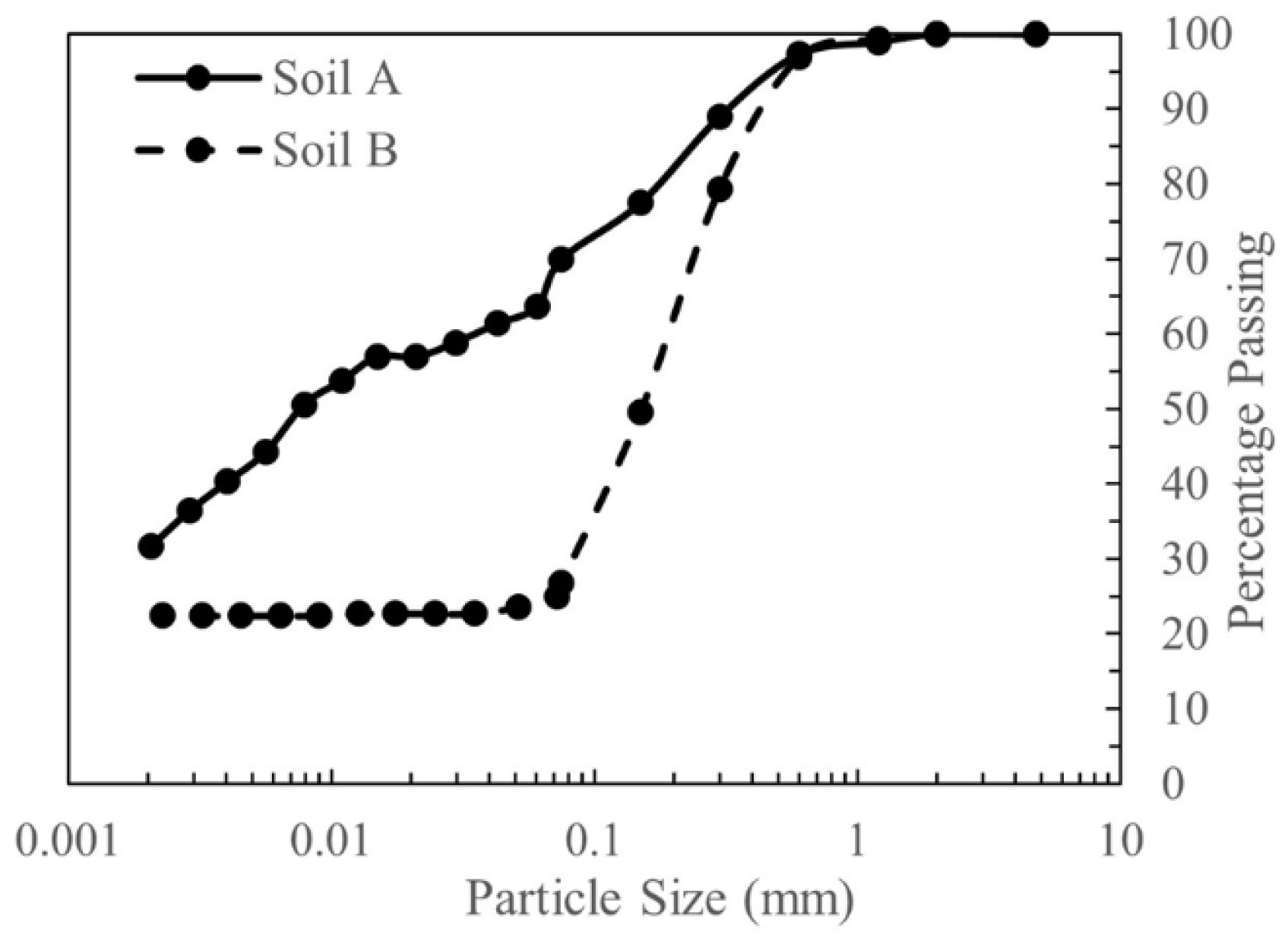
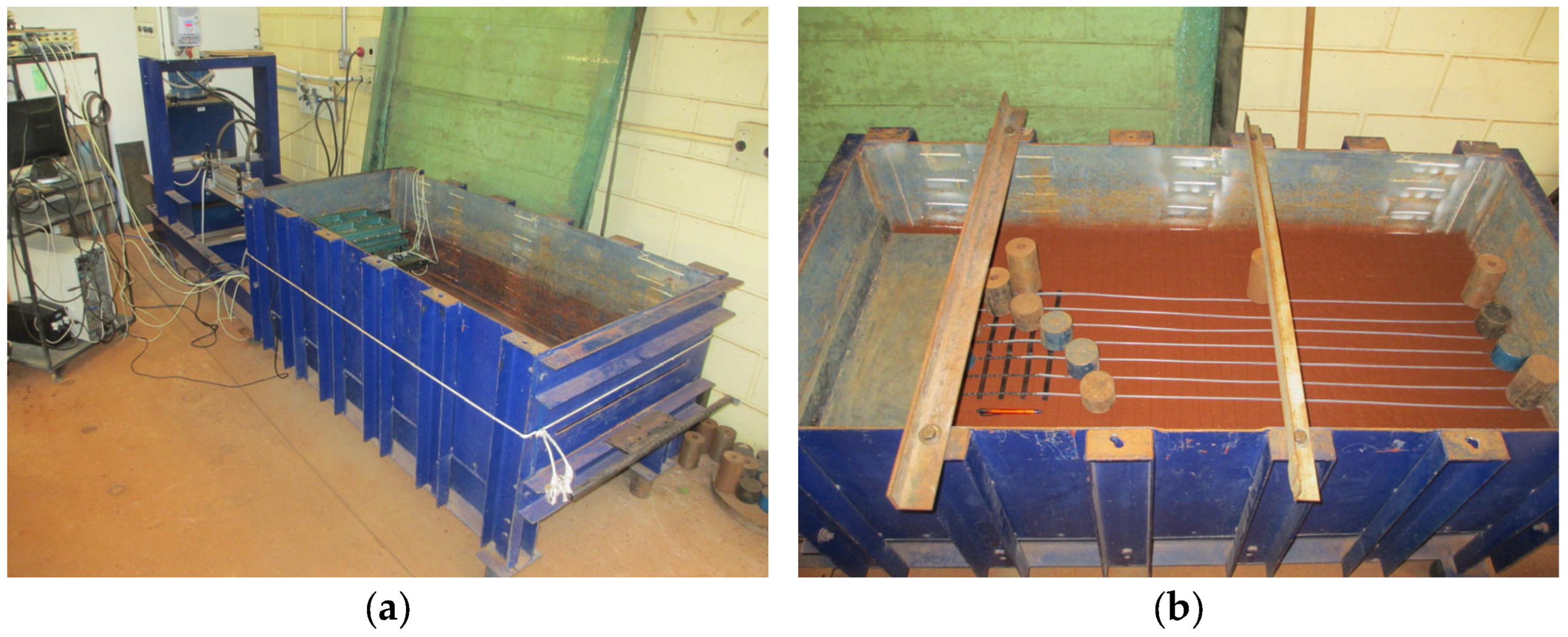
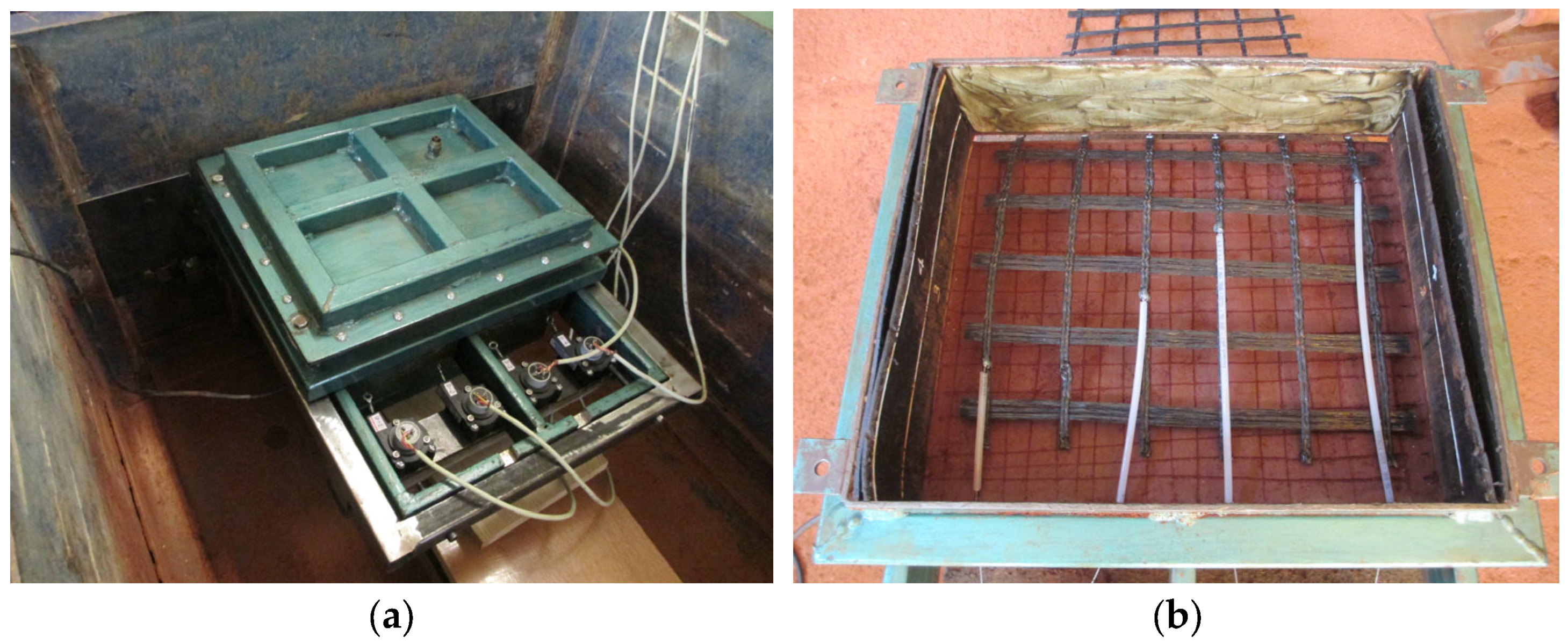
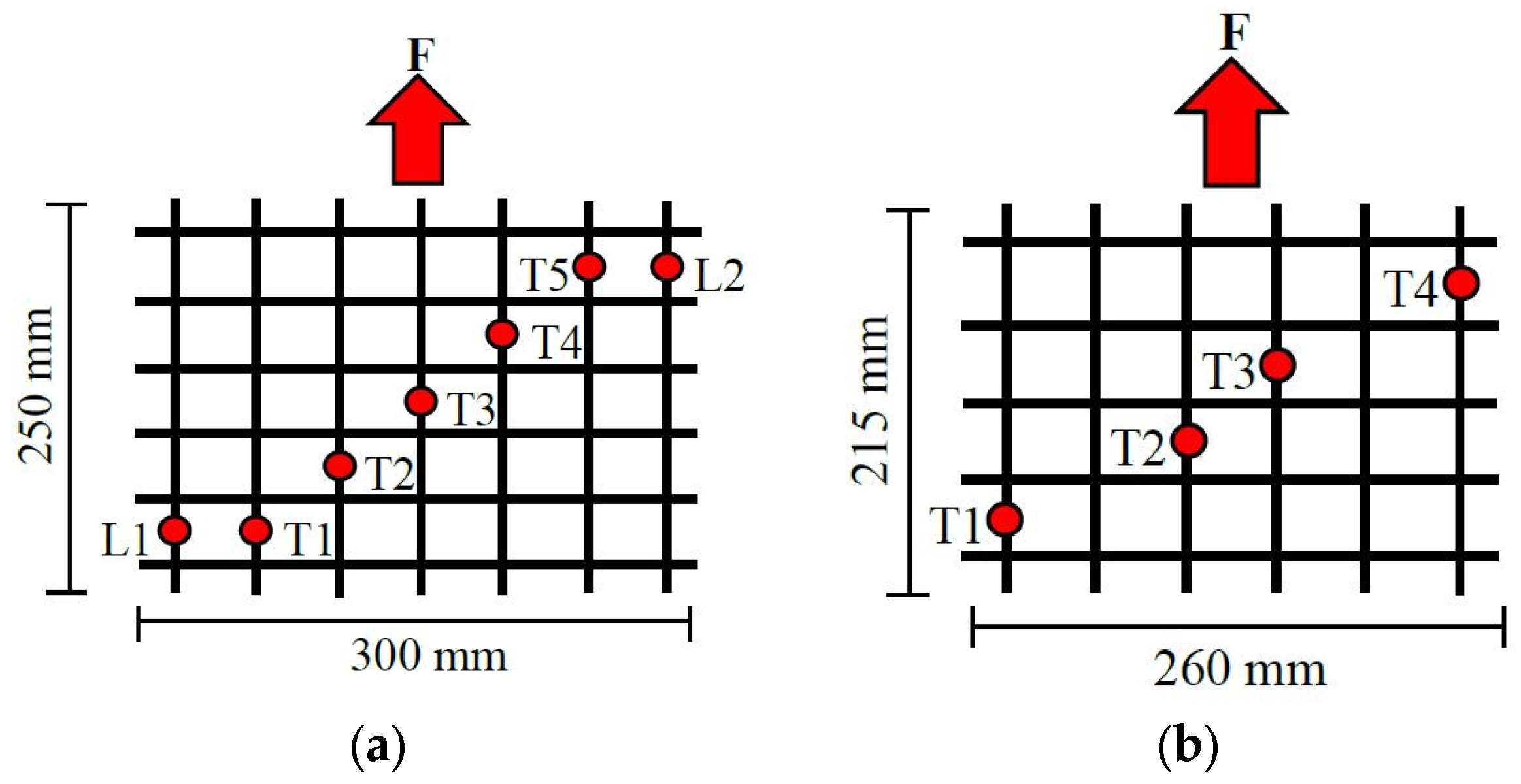


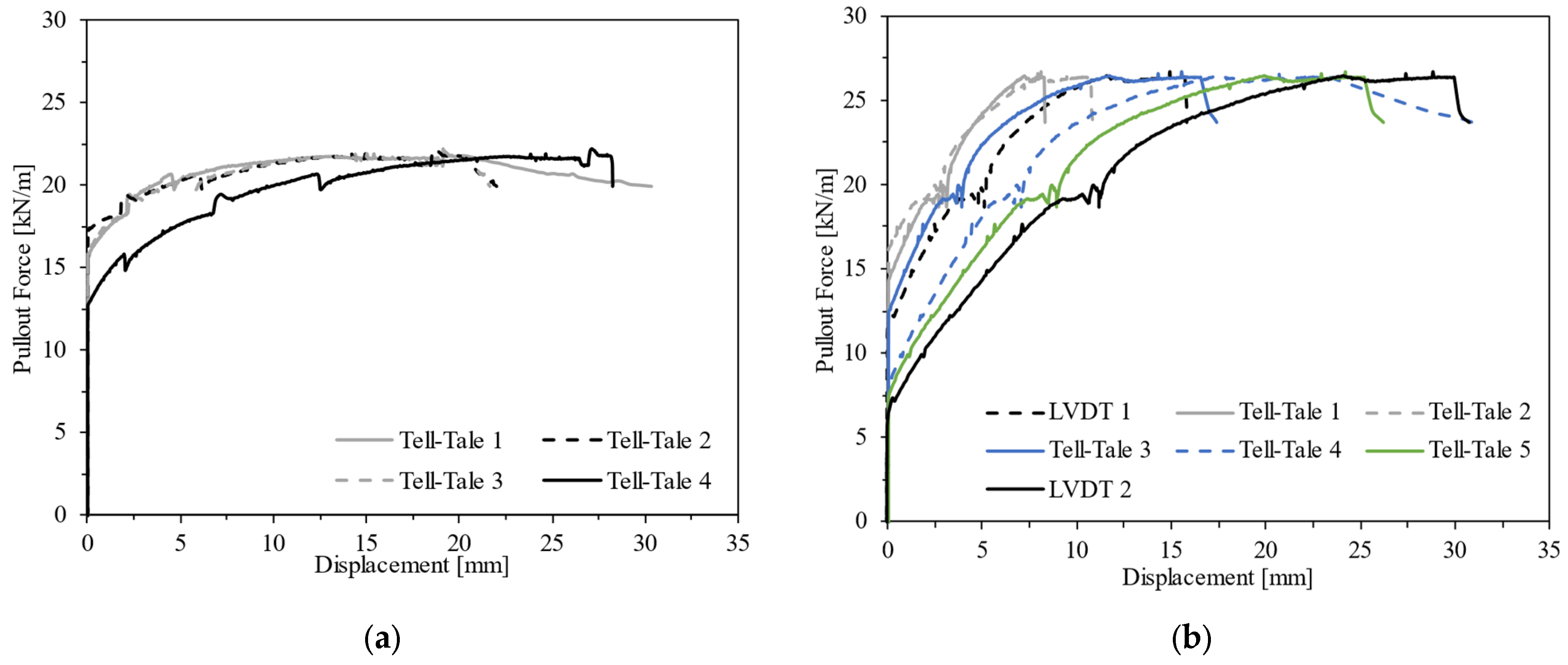

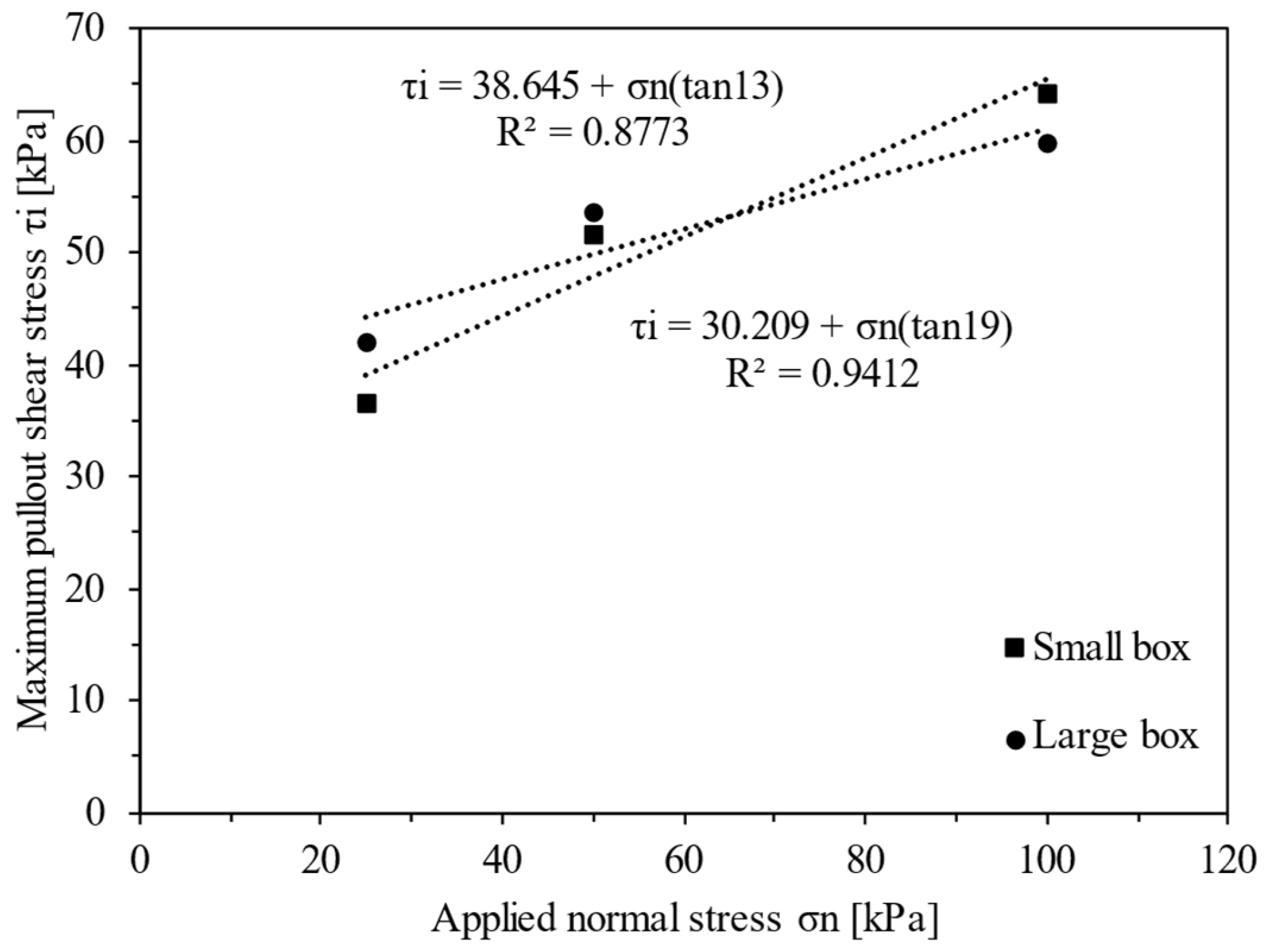
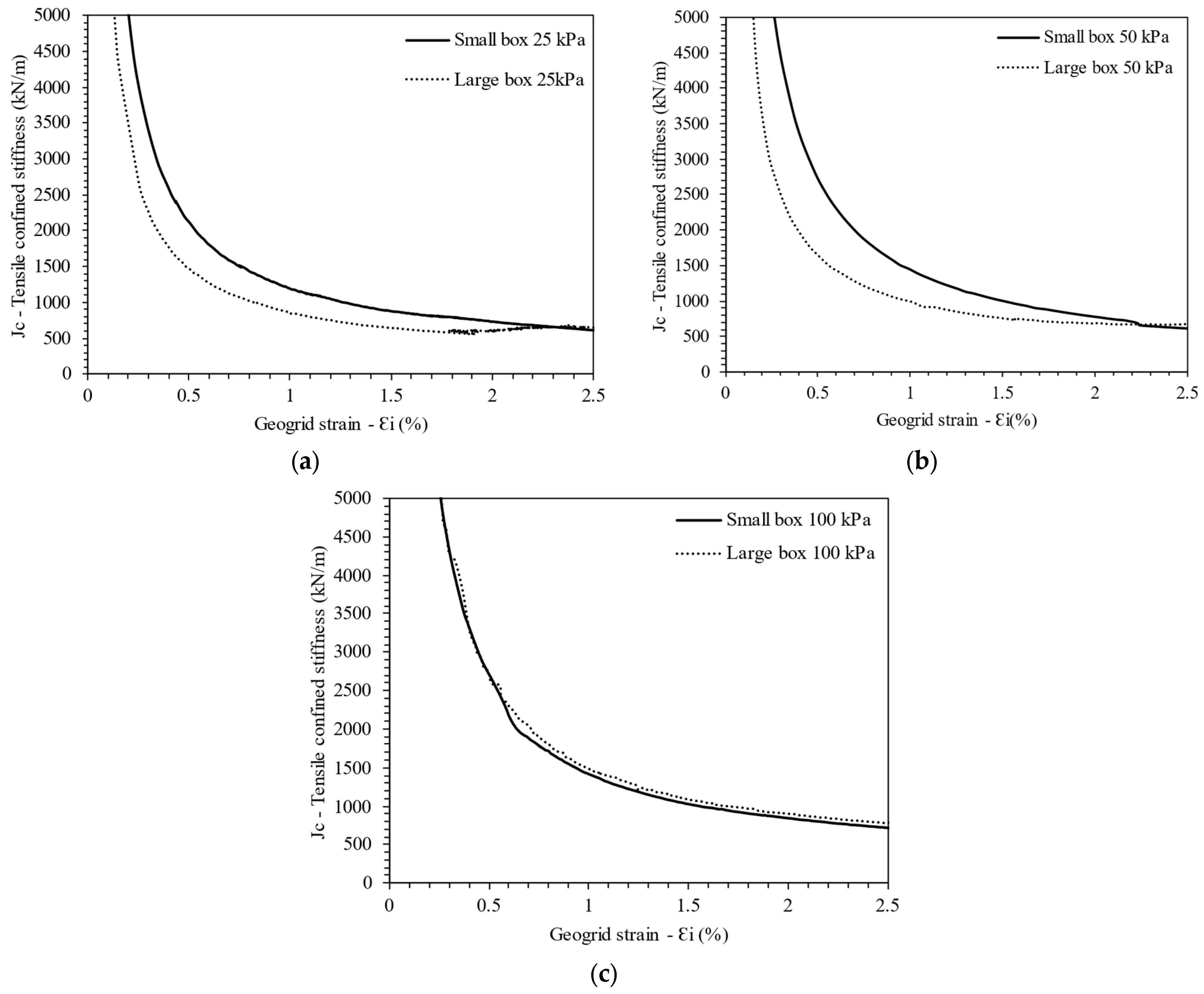

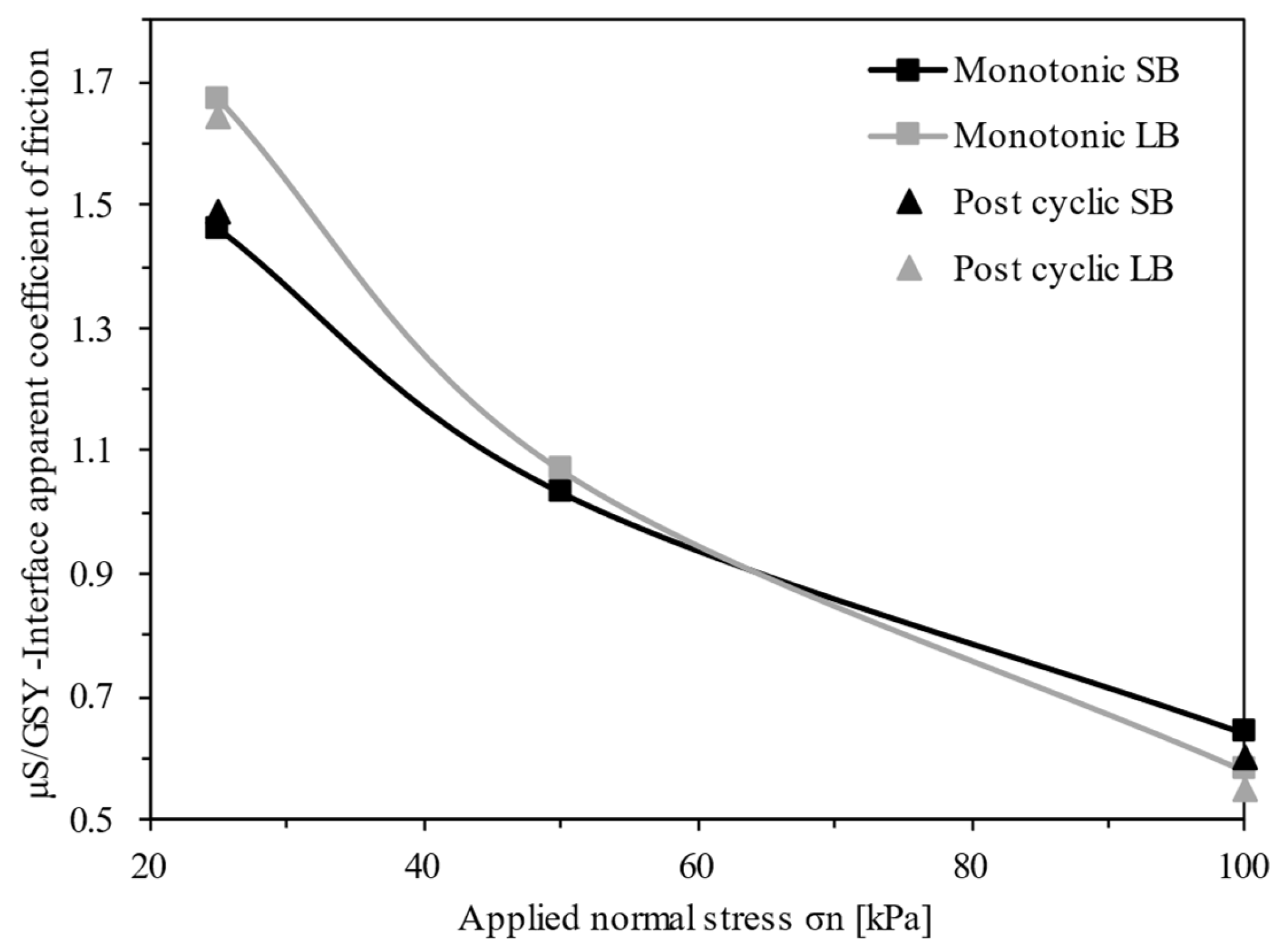
| Property | Unit | Soil A | Soil B |
|---|---|---|---|
| Classification (USCS) | - | MH | SC |
| Specific gravity, GS | - | 2.913 | 2.646 |
| Liquid limit, wL | % | 55 | 16 |
| Plastic limit, wP | % | 32 | - |
| Maximum dry unit weight, γd,máx | g/cm3 | 1.626 | 1.983 |
| Optimum water content, wop | % | 22.75 | 9.24 |
| Friction angle, ϕ | º | 27 | 31 |
| Cohesion, c | kPa | 66.27 | 34.64 |
| Property | Unit | Value |
|---|---|---|
| Polymer | - | PP |
| Thickness | mm | 1.05 |
| Mean grid size | mm | 45 × 45 |
| Short-term tensile strength | kN/m | 43.24 |
| Elongation at maximum load | % | 5.75 |
| Secant stiffness at 5% strain | kN/m | 523 |
| Test | PR (kN/m) | uPR (mm) | JC2% (kN/m) | τi (kPa) | μs/GSY | σn (kPa) | Equipment |
|---|---|---|---|---|---|---|---|
| 1 | 15.68 | 27.16 | 725 | 36.47 | 1.46 | 25 | SB |
| 2 | 22.19 | 25.55 | 779 | 51.61 | 1.03 | 50 | SB |
| 3 | 27.57 | 15.82 | 838 | 64.12 | 0.64 | 100 | SB |
| 4 | 20.90 | 28.07 | 632 | 41.81 | 1.67 | 25 | LB |
| 5 | 26.70 | 20.05 | 686 | 53.40 | 1.06 | 50 | LB |
| 6 | 28.93 | 8.19 | 852 | 59.73 | 0.58 | 100 | LB |
| Test | PR (kN/m) | τcyc/τmon (kPa) | μs/GSY | σn (kPa) | Equipment |
|---|---|---|---|---|---|
| 1 | 15.98 | 1.12 | 1.48 | 25 | SB |
| 2 | 20.50 | 1.06 | 1.64 | 25 | LB |
| 3 | 22.39 | 0.95 | 0.60 | 100 | SB |
| 4 | 27.35 | 0.97 | 0.55 | 100 | LB |
| Monotonic | σn = 25 kPa | σn = 50 kPa | σn = 100 kPa |
| PR | 0.75 | 0.83 | 0.95 |
| τi | 0.87 | 0.97 | 1.07 |
| μs/GSY | 0.87 | 0.97 | 1.11 |
| Cyclic/post-cyclic | σn = 25 kPa | σn = 100 kPa | |
| PR | 0.78 | 0.94 | |
| τi | 0.92 | 1.06 | |
| μs/GSY | 0.91 | 1.10 |
Disclaimer/Publisher’s Note: The statements, opinions and data contained in all publications are solely those of the individual author(s) and contributor(s) and not of MDPI and/or the editor(s). MDPI and/or the editor(s) disclaim responsibility for any injury to people or property resulting from any ideas, methods, instructions or products referred to in the content. |
© 2024 by the authors. Licensee MDPI, Basel, Switzerland. This article is an open access article distributed under the terms and conditions of the Creative Commons Attribution (CC BY) license (https://creativecommons.org/licenses/by/4.0/).
Share and Cite
Barajas, S.R.; Pedroso, G.O.M.; Ferreira, F.B.; Lins da Silva, J. Influence of Apparatus Scale on Geogrid Monotonic and Cyclic/Post-Cyclic Pullout Behavior in Cohesive Soils. Appl. Sci. 2024, 14, 5861. https://doi.org/10.3390/app14135861
Barajas SR, Pedroso GOM, Ferreira FB, Lins da Silva J. Influence of Apparatus Scale on Geogrid Monotonic and Cyclic/Post-Cyclic Pullout Behavior in Cohesive Soils. Applied Sciences. 2024; 14(13):5861. https://doi.org/10.3390/app14135861
Chicago/Turabian StyleBarajas, Sergio Rincón, Gabriel Orquizas Mattielo Pedroso, Fernanda Bessa Ferreira, and Jefferson Lins da Silva. 2024. "Influence of Apparatus Scale on Geogrid Monotonic and Cyclic/Post-Cyclic Pullout Behavior in Cohesive Soils" Applied Sciences 14, no. 13: 5861. https://doi.org/10.3390/app14135861








